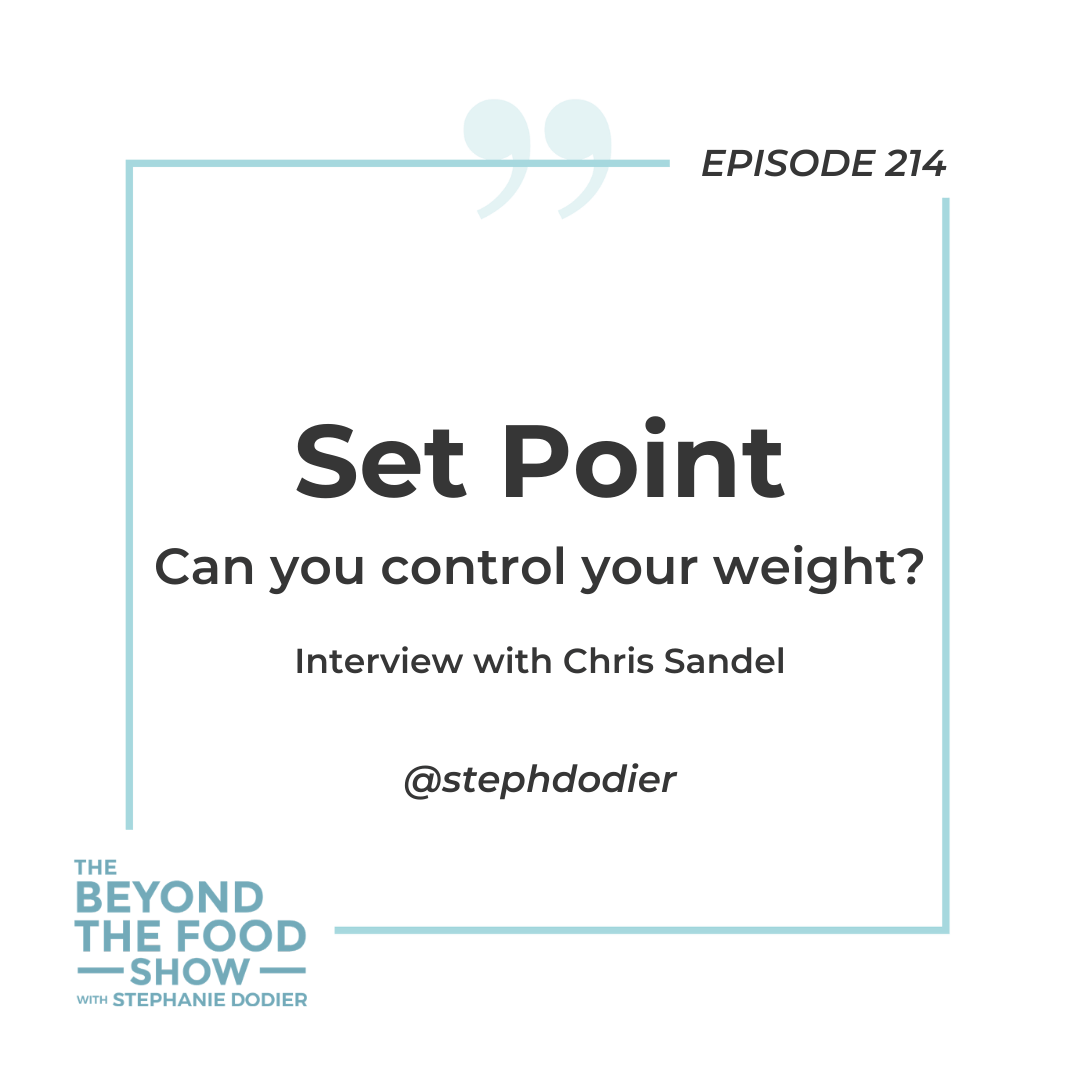
In today’s episode, we’ll talk set point
Think of your set point like a natural mechanism your body uses to maintain a natural weight. Just like your lungs manage the appropriate amount of oxygen for your body without you having to do anything or the way in which your heart manage your blood pressure.
Another fascinating analogy is how your brain automatically gets you back steady on a bike even if it’s been 10 years since your last ride…it just happens without you having to think about it. Set point manages your weight in the same way.
What is set point?
In her book Health Every Size, Dr. Linda Bacon describes it as the Fat thermostat in our bodies. It acts just like a heat thermostat in a room. When set to a certain temperature, the thermostat will send a message to the heating system to activate when below a determined temperature. Your hypothalamus, the region of the brain that controls the system in your body that regulates your set point. It will send a message of hunger and fullness to manage your weight. This will make you think of the cookies in the cupboard and will also make you say no to the pizza when you’re full.
Our set point manages all the various components in the complex human body that create our body weight. Your set point is your ideal body weight, the bodyweight you manage naturally without food restriction, deprivation, over-exercise. Your set point is your weight between diet. The weight at which you can live a non-food or exercise-obsessed life. Set point is the internal system to maintain a healthy weight.
An example…
One 1970s research study showed that the average weight of a sixty-year-old man was only four to five pounds more than the average thirty-year-old man. That kind of weight maintenance is no accident and not the consequence of dieting either.
Dr. Bacon has this very powerful example in her book Health at Every Size:
“Just consider a fifty-year-old woman who weighs about five pounds more than she did when she was twenty. If she eats about 2,000 calories a day, over the course of thirty years she takes in about 22 million calories. Since five pounds of body fat stores about 17,500 calories, that means that her body was just .08 percent off in balancing energy in vs. energy out. This amounts to a difference of about 50 calories per month—less than the calories in one egg!” -Bacon, Linda. Health at Every Size: The Surprising Truth About Your Weight (p. 12).
Our set point is our natural weight and it can fluctuate during our lifetime. Currently, research estimates the fluctuation to beta between 10-20lbs. Set point fluctuates so it can maintain homeostasis.
Homeostasis & happiness set point theory
Homeostasis is the ability of the human body to maintain a stable environment is key to our survival. The magical ability that our body has to adapt to its environment given any condition is what is allowing to survive.
This ability to maintain balance is what maintains stable body temperature, stable blood pressure, stable level of iron, blood glucose, and yes, body weight. All of these biological systems are focused on maintaining homeostasis, aka balance, so we can survive and thrive in our environment.
It goes beyond the human physical body. Homeostasis is also what creates your thoughts and your emotions. Your mind responds to its emotional environment as well.
The happiness set point theory is almost similar to the body weight set point theory. It suggests that our level of subjective well-being is determined primarily by heredity and by personality traits ingrained in us early in life, and as a result, remains relatively constant throughout our lives. Our level of happiness may change temporarily in response to life events, but then almost always returns to its baseline level.
For humans, homeostasis means survival and our body will do anything to bring us back to homeostasis so we can survive, including the dreaded weight gain.
Identifying and manipulating your set point
Are you at your set point now? That’s a very good question which unfortunately is not that simple to answer. How much fat protection your body requires (your set point) is the result of a complex interplay of genetics and the lifestyle choices made today as well as in the past.
You see, at this time we do not have a tool that will allow us to determine an individual set point nor do we have the knowledge on how to manipulate someone’s set point either. The complexity of the human body and the number of elements involved in managing it exceed our scientific capacity as of today 2019.
So, to be clear sister, if you see a headline claiming to have the secret trick to lower your set point or what I have seen recently the 21 days set point reset detox… that 100% diet culture in action. It’s a lie, fraud. It’s just another gimmick from someone wanting to make money from your despair about your body weight.
What we do know is that if we want our body to settle at a natural weight that is effortless and healthy, we must make our brain feel safe. When the brain feels safe it will provide messages to the body that it is safe. Will you lose weight? We do not know… no one knows. But what we know is that health arises or is maintained in a safe physical and psychological environment.
Why is dieting not the answer
Dieting or over-exercising is not a safe environment for humans. Point.
The human body perceives intentional weight loss as a threat. That’s why diets do not work. Your body will adapt to the starvation/ deprivation period during the diet with weight loss and as soon as you release the pressure of the unsafe environment (aka stop dieting or over-exercising). The body will come right back to your set point and in many cases higher to ensure complete protection from further weight loss threat.
What can we do? Based on all the current research, I’d like to suggest focusing on creating a relationship of trust and respect for the innate wisdom of our human body. Foster a safe environment both psychologically and physically that you and your body can not only survive in but thrive.
The best place to get started is to educate and understand what could be perceived by your body as unsafe especially when it comes to food and body weight.
I would encourage you to get started by listening to episode 214 of the Going Beyond The Food Podcast right up to the end where I saver with you a tool to help you determine what could be impacting your set point. A free checklist and resource to get you started on your journey to trust & respect for your body.
Our guest expert for this episode 214 is Chris Sandel, a UK–based nutritionist and the host of Real Health Radio. Chris’ approach to food and health is non-dogmatic. His areas of expertise are diet recovery, eating disorders, body image, hormonal health (fertility and thyroid issues), metabolism, habit formation, nutrition, eating habits, physiology, exercise, and movement.
What you’ll learn listening to this episode:
- What is weight set point theory?
- In what way does the body determine our set point?
- How much do genetics influence weight?
- How does the body keep us at our set point?
- “calories in, calories out” is it true?
- How could someone end up above their set point?
- How trauma can affect set point
- Next steps for you to reframe who you think about weight
Mentioned on the show:
Chris overeating experiment podcast
Minnesota Starvation Study Podcast
Resources mentioned on the show:
Dr. Linda Bacon Set point tool






